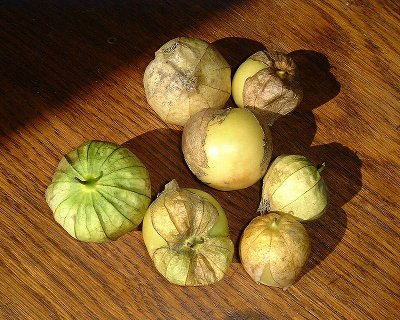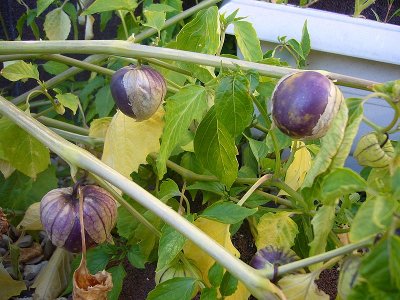Tomatillo
 Common Names: Tomatillo, Mexican husk tomato, Mexican ground cherry, Mexican green tomato, miltomato
Common Names: Tomatillo, Mexican husk tomato, Mexican ground cherry, Mexican green tomato, miltomato
Scientific Name: Physalis philadelphica
Climate: Warm
Plant Description: The tomatillo is from the nightshade family. It has slightly hairy stems and grows to about one meter in height. The green leaves are oval shaped and serrated. The flowers are usually yellow and dark in the middle but they can also be white or purple.
The tomatillo is known as a self-incompatible plant, which means that two plants are for pollination to occur. After pollination, the calyx forms a husk around the fruit. The fruit is about five centimeters in diameter.
Cultivation: Tomatillos are grown similarly to tomatoes but tend to be a stronger plant. They are sensitive to cold and grow best in warm climates in direct sunlight. If they are grown in colder climates, they should be planted after all danger of frost has passed. They are typically sprouted about six to eight weeks before planting. Seeds germinate one or two weeks after planting. They can be transplanted when they are between ten and 15 centimeters high. As they produce a lot of branches, they should be planted at a distance of about one meter and are best grown with some type of support to prevent them falling over or from the fruits touching the ground.
Tomatillos adapt to a variety of soils but prefer well drained soils with plenty of organic material. It is not advisable to plant them where tomatoes, potatoes or peppers have been growing. They grow best in direct sunlight and require moderate watering. Once or twice a week is usually sufficient, but this needs to be more frequent in warmer weather and when they are producing fruit.
The fruit is ready to harvest two to three months after planting. Normally it is left for about two weeks to allow the husk to dry and it can be kept for about three weeks more.
 Uses: Tomatillo contains iron, potassium, fiber and vitamins C and K. It stimulates the production of white blood cells, boosting the immune system. It contains antioxidants which remove toxins from the system. It is suitable for people with diabetes as it helps to regulate blood sugars. It is high in fibers and low in calories so can be used to prevent obesity.
Uses: Tomatillo contains iron, potassium, fiber and vitamins C and K. It stimulates the production of white blood cells, boosting the immune system. It contains antioxidants which remove toxins from the system. It is suitable for people with diabetes as it helps to regulate blood sugars. It is high in fibers and low in calories so can be used to prevent obesity.
Tomatillos can be eaten fresh in salads. They are a popular ingredient in soups and stews. They are commonly used in green sauces, mixed with chillies, in Mexico.
Pests and Diseases: The tomatillo suffers from few serious pests or diseases. Of these, the most serious are cutworms, whiteflies, and tobacco mosaic virus. Sticky yellow traps are a very effective and eco-friendly way to control the whitefly. A dilution of garlic applied to the leaves also keeps it away. Plants infected with the virus must be removed and destroyed.
References:
https://www.britannica.com/plant/tomatilloof
https://harvesttotable.com/tomatillos-seed-starting-tips/
ttps://globalfoodbook.com/10-exceptional-benefits-of-tomatillo
En español: Tomatillo
